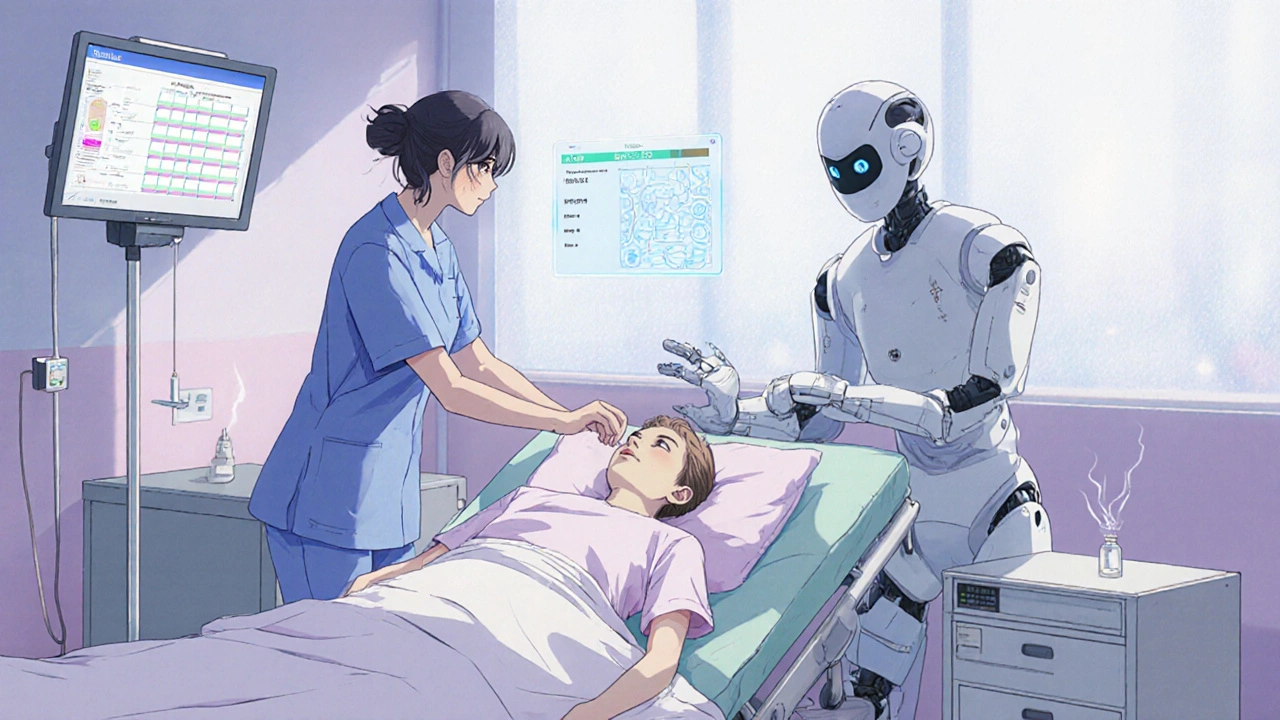Surgical Pain Management Calculator
Why This Matters: Evidence shows multimodal pain management reduces opioid use by 30-40% and shortens recovery time by 20% according to 2023-2024 ERAS studies.
When you wake up after surgery, the quality of your recovery often hinges on the people watching over you while the anesthesia wears off. The Anesthesia Care Team is a multidisciplinary group that includes an anesthesiologist, a certified registered nurse anesthetist (CRNA), and dedicated anesthesia nurses. Together they manage everything from the initial drug dose to the moment you take your first steps home. Understanding how this team works can empower you to ask the right questions and set realistic expectations for a smoother postoperative journey.
Who Makes Up the Anesthesia Care Team?
At its core, the Anesthesia Care Team blends three key professionals:
- Anesthesiologist - a physician who directs the overall anesthetic plan, monitors vital signs, and intervenes in emergencies.
- Certified Registered Nurse Anesthetist (CRNA) - an advanced practice nurse who can independently administer and adjust anesthesia, especially in regional blocks.
- Anesthesia Nurse - a registered nurse who prepares medications, assists with airway management, and provides bedside support during the recovery phase.
Each member brings a distinct skill set, but they all share a single goal: keep you safe and comfortable from induction through discharge.
Early Recovery: Pain, Nausea, and Comfort
Two of the biggest hurdles in the first 24 hours after surgery are pain and postoperative nausea and vomiting (PONV). The team tackles these issues through a layered approach:
- Pre‑emptive analgesia - giving non‑opioid meds (acetaminophen, gabapentin) before the incision reduces the need for strong opioids later.
- Regional techniques - nerve blocks or spinal anesthesia provide targeted pain relief without systemic side effects.
- Opioid‑sparing strategies - using low‑dose ketamine or lidocaine infusions helps control pain while lowering opioid‑related nausea.
- Antiemetic prophylaxis - the team often administers a combo of dexamethasone and ondansetron based on the patient’s risk profile.
Because the anesthesia professionals control the timing and dosage of these drugs, they can fine‑tune therapy in real time, often preventing severe pain spikes before they happen.
Enhanced Recovery After Surgery (ERAS) - The Team’s Playbook
ERAS protocols are evidence‑based pathways that accelerate healing and cut complications. The Anesthesia Care Team is the linchpin of ERAS for three reasons:
- Optimized fluid balance - goal‑directed fluid therapy avoids both dehydration and excess overload, which can delay gut function.
- Early mobilization support - by minimizing sedation and pain, the team clears the way for patients to sit up and walk within hours of surgery.
- Standardized medication regimens - pre‑set orders for multimodal analgesia simplify coordination among surgeons, nurses, and pharmacists.
Studies in 2023‑2024 showed that ERAS‑compliant patients experienced a 30 % reduction in length‑of‑stay and a 20 % drop in postoperative complications, underscoring the team’s impact.

Communication & Patient Education
Patients often feel anxious about what to expect once the anesthesia wears off. The team bridges that knowledge gap through:
- Pre‑operative counseling sessions that outline likely sensations, pain levels, and recovery milestones.
- Post‑operative briefings where the anesthesia nurse reviews medication schedules, alarm signs (e.g., worsening pain, persistent nausea), and discharge instructions.
- Written handouts and digital resources that patients can reference at home, reducing the need for emergency calls.
Clear communication not only eases fear but also improves adherence to pain‑control plans, which directly translates to faster healing.
Managing Complications: Airway, Hemodynamics, and Delirium
While most surgeries go smoothly, complications can arise. The team is trained to intervene quickly on three fronts:
- Airway protection - if breathing becomes shallow or secretions build up, the anesthesiologist can re‑intubate or apply non‑invasive ventilation.
- Hemodynamic stability - rapid drops in blood pressure are corrected with vasopressors or fluid adjustments, preventing organ hypoperfusion.
- Post‑operative delirium - especially in older adults, the team monitors cognitive status, adjusts sedatives, and ensures adequate oxygenation.
These interventions often happen behind the scenes, but they are critical to keeping you on track for a safe discharge.
Collaboration With Surgeons and Nursing Staff
Recovery is a team sport. The anesthesia professionals coordinate with surgeons, floor nurses, and physiotherapists through:
- Daily briefings that review pain scores, nausea levels, and mobility goals.
- Shared electronic health record (EHR) notes that flag high‑risk patients (e.g., opioid‑tolerant, sleep apnea).
- Joint decision‑making on when to taper IV meds, switch to oral analgesics, and clear the patient for discharge.
This seamless handoff reduces delays, prevents medication errors, and ensures that every caregiver is on the same page.

Patient Checklist: What to Expect From the Anesthesia Care Team
- Before surgery: A 15‑minute consult covering anesthesia type, pain plan, and any allergies.
- During surgery: Continuous monitoring of heart rate, blood pressure, and oxygen levels.
- Immediate post‑op: Warm blankets, IV analgesic titration, and anti‑nausea meds as needed.
- First 24 hours: Regular pain assessments, early ambulation assistance, and clear instructions for medication at home.
- Discharge day: A written summary of pain meds, warning signs, and a follow‑up phone call from the anesthesia nurse within 48 hours.
Having this checklist helps you stay organized and makes it easier to ask the team for clarification if something feels off.
Quick Reference Table: Roles & Key Responsibilities
| Member | Primary Training | Typical Duties |
|---|---|---|
| Anesthesiologist | MD, residency + fellowship | Designs anesthesia plan, oversees hemodynamics, handles emergencies. |
| CRNA | Advanced‑practice RN, 2‑year graduate program | Administers drugs, performs regional blocks, monitors recovery. |
| Anesthesia Nurse | RN certification | Preps meds, assists airway management, provides bedside education. |
Takeaway: Why the Team Matters
From the moment the anesthesia machine powers up to the few minutes before you walk out the door, the anesthesia care team tailors drug choices, monitors vital signals, and keeps you comfortable. Their expertise shortens hospital stays, reduces complications, and helps you get back to your daily routine faster. Knowing what each member does lets you partner with them, ask informed questions, and set realistic expectations for a smoother surgical recovery.
What does an anesthesiologist do during surgery?
The anesthesiologist creates the overall anesthesia plan, monitors heart rate, blood pressure, and oxygen levels, and steps in for any emergency airway or hemodynamic issues.
How can I reduce postoperative nausea?
Ask the anesthesia team about receiving both dexamethasone and ondansetron before the incision; staying hydrated and moving early also help.
What’s the difference between a CRNA and an anesthesiologist?
A CRNA is an advanced‑practice nurse who can independently deliver anesthesia, while an anesthesiologist is a medical doctor with broader training and the authority to handle complex cases and emergencies.
Why is multimodal analgesia important?
Using several drug classes (acetaminophen, NSAIDs, regional blocks) lowers the need for opioids, which cuts the risk of nausea, constipation, and respiratory depression.
How soon can I start walking after surgery?
With ERAS protocols and proper pain control, many patients stand and take a short walk within 2‑4 hours after waking up, but follow the specific instructions from your anesthesia nurse.

Caroline Keller
I can’t stand the idea that anyone would skip the team’s pain plan
dennis turcios
The article throws a lot of buzzwords at the reader without showing real numbers. The ERAS stats are impressive but they need a citation. The anesthesia team is indeed vital yet the piece glosses over the cost of staffing. The lack of patient perspective leaves a gap.
parth gajjar
When I stepped into the OR I felt the weight of centuries of anesthetic mastery bearing down on my nerves. The anesthesiologist a conductor of life orchestrates every heartbeat with uncanny precision. The CRNA a virtuoso of regional blocks shapes pain into a lullaby that whispers through nerves. The anesthesia nurse the silent guardian steadies the infusion like a watchful sentinel. In the aftermath the patient rises not merely healed but reborn. The layered analgesia is not a gimmick it is a symphony of pharmacology. The anti‑emetic cocktail is a shield against the chaos of nausea. The team’s coordination is the invisible thread weaving recovery together.
Maridel Frey
Thank you for highlighting the collaborative nature of the anesthesia team. Your description captures the essential roles well. It is important for patients to recognize each member’s contribution to safety and comfort. Clear communication about these responsibilities can empower individuals during the peri‑operative period.
Jay Kay
The post makes it sound like the anesthesia crew is a magic fix. In reality the outcomes depend on many variables. Not every hospital has enough CRNAs to run regional blocks. Patients should still ask about their personal plan. Blind trust can be risky.
Rakhi Kasana
You raise valid concerns but the tone feels overly cautious. While staffing limits exist, many centers have refined protocols that work well. It’s a balance between optimism and realism.
Sarah Unrath
i didnt know the aneshtesia nurse does that much dont they just assist?
James Dean
The anesthesia care team operates at the intersection of physiology and technology. Each member holds a responsibility that extends beyond the operating room. Anesthesiologists design the overarching plan and adjust it in real time. CRNAs execute the plan with skillful dosing and regional techniques. Anesthesia nurses prepare the drugs and monitor the patient’s immediate response. Together they create a feedback loop that balances pain relief with safety. In enhanced recovery protocols the timing of analgesics determines how quickly mobility can commence. Goal‑directed fluid therapy prevents both hypovolemia and overload, protecting organ function. The proactive anti‑nausea regimen reduces the incidence of vomiting, a major cause of delayed discharge. When complications arise the team’s training enables rapid airway protection and hemodynamic support. Post‑operative delirium is mitigated by vigilant assessment and judicious sedative use. Communication with surgeons and floor nurses ensures that medication orders are synchronized. Electronic health records allow real‑time flagging of high‑risk patients. The cumulative effect of these coordinated actions is a measurable drop in length of stay and complication rates. Understanding this synergy helps patients appreciate why asking about the anesthesia plan is worthwhile.